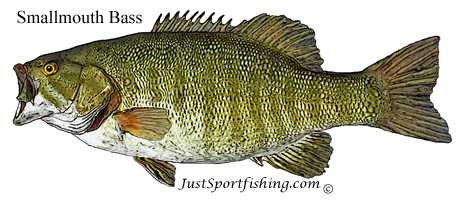|
Home Game Fish Fishing Knots Tackle Tips Videos Pictures Tips Rods & Reels Boats Cook your Catch Articles About Contact |
|
Donate to JustSportfishing.com and help to build the largest fishing information site on the web. Even a dollar or two will keep us building this free site.
|
Smallmouth
Bass World
Record
~ 10 Lbs. 14 oz. Caught at Dale Hollow, TN on Apr. 24, 1969 by angler
John T. Gorman. Scientific
name
~ Micropterus Dolomieu Other
names
~ Bronzeback, Brown Bass, Black Bass, Oswego Bass, Redeye, Smallie,
Brownie Identification ~ The Smallmouth Bass has a robust, laterally compressed body and a large, long, head with dark bars which radiate back from the eyes. A long, blunt snout with a slightly longer lower jaw. Two joined dorsal fins which appear as one. The back and top of the Smallmouths head are brown, golden brown through olive to green and the sides are lighter than the back, more golden with golden flecks on most scales and marked by 8 - 15 pronounced to vague, thin vertical bars. The belly is cream to milk-white with the pectoral fins being clear and the others are opaque, dark to amber with some black on rays, spines or membranes. The body color is can be variable with size, condition and habitat, in clear water hey are darker with pronounced, contrasting markings, and, in turbid water they are lighter with vague markings.
Size
~ Most Smallmouth Bass that anglers catch are from 9 to 14 inches in
length and under 2 pounds. Habitat
~ Smallmouth Bass prefer clear, calm waters and seek out areas with
gravel, rubble, or rocky bottoms. They live in midsize, gentle streams
that offer deep pools and plenty of shade, or in fairly deep, clear
lakes and reservoirs with rocky bluffs, steep drop-offs and large
shoals. They will also utilize weed beds and other vegetation,
especially if found near some type of rock. Although they are fairly
adaptable, they are rarely found in murky water. Smallmouth will inhabit
rivers and streams with strong current but will spend most of their
lives in areas that are sheltered from current. Mature Smallmouths
prefer rocky, shallow areas of lakes and rivers and retreat to deeper
waters as temperatures rise. They tend to seek cover and avoid bright
sunlight. They hide in deep water, behind rocks and boulders, and around
underwater debris and crevices, preferring water temperatures between 66
and 72 F. Feeding
Habits
~ Adult Smallmouth Bass eat mostly fish such as darters, minnows, yellow
perch, sunfish. They also consume crayfish, tadpoles,
and leeches. The preferred diet is crayfish and when plentiful
will seek out these first.
|


